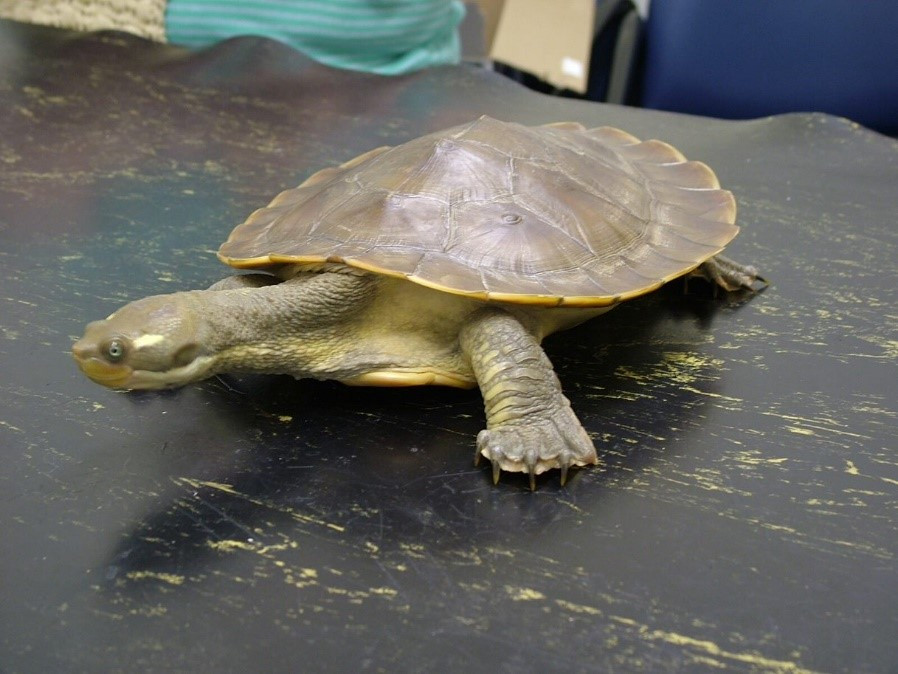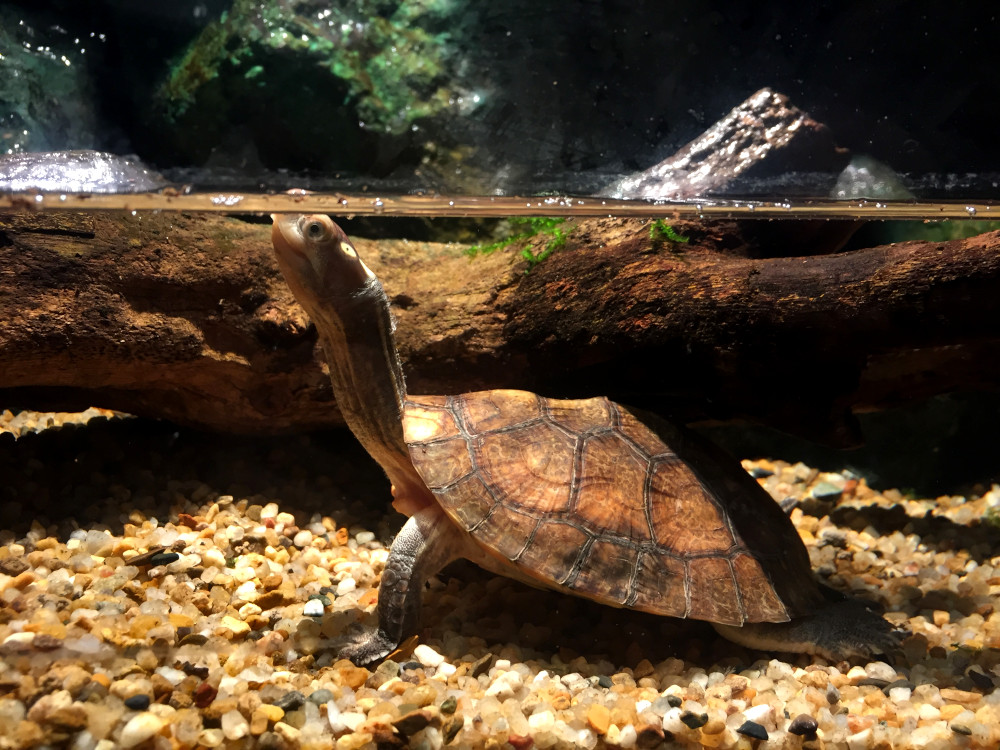Australia is home to over 20 species of freshwater turtle. They all share the characteristic of retracting their head and neck beneath their shell by folding it to one side (‘side-necked’ turtles), rather than drawing their head backwards as do most of the world’s species of turtles and tortoises.
They are broadly divided into two groups – the long-necked turtles (Chelodina species – e.g., the eastern long-neck and the broad-shelled turtles) and the short-neck turtles (Emydura and Myuchelys species – e.g., Macquarie River, Murray River, saw-shelled turtles). The main species of turtles kept as pets in Australia are the eastern long-neck turtle (Chelodina longicollis) and the short-necked turtles such as Murray River turtle (Emydura macquarii macquarii). More stringent permit conditions normally apply to keeping the broad-shelled Turtle (Chelodina expansa) and some other species.


They are all semi-aquatic turtles; they live in water but must be able to access land.
General information
Common names:
Eastern long-neck turtle (Chelodina longicollis)
Murray River turtle (Emydura macquarii macquarii).
Natural habitat: These turtles are found in NSW and south-east Queensland. The Eastern Long-neck turtle prefers swamps, lakes, billabongs, and slow-moving weedy rivers and streams, but can also occur in swift-flowing watercourses and can be found dispersing overland. The Murray River turtle occurs along rivers, creeks, and lagoons, often in larger rivers and large waterholes; it is frequently seen basking on emergent logs or rocks (logs or rocks that are poking out of the water).
Wild diet: The Eastern Long-neck turtle is an opportunistic carnivore, feeding on fish carrion, crayfish, small fish, and insects. The Murray River turtle is an opportunistic omnivore, eating algae, carrion, aquatic insects, and aquatic plants (N.B., carrion and invertebrates appear to be essential dietary items for this species).
Appearance: The eastern long-neck turtle is a medium-sized turtle, its carapace (top shell) measuring up to 25 cm in length, with a long slender neck. The Murray River Turtle is a brown turtle with a pale yellow or cream stripe extending from the mouth back along the neck. They can be quite large, with a carapace length of up to 34 cm.
Behaviour: Turtles are not social animals. In most cases they interact with each other out of necessity, not because they enjoy each other’ company. It doesn’t mean that turtles can’t get along in bigger groups; they can get along fine if there is enough space and resources.
Keeping a Turtle
Even though these are a common species, you should carefully consider whether a turtle is the right pet for you. For information on what to think about before making that decision, please see this article. You also must obtain a licence to keep turtles. There are a wide range of sources from where you can obtain a turtle, but you must not take them from the wild, nor are you allowed to release a pet animal to the wild. If your turtle outgrows their home or your circumstances change and you can no longer care for the turtle contact an organisation like such as the RSPCA, which may be able to assist in re-homing.
As they are not a social animal, you do not need to buy two to keep each company. In fact, in the confines of a tank, aggression between two turtles is common, especially as the dominant turtle often grows faster and larger than the other.
Little is known about the life span of Australian freshwater turtles, but they can probably live for 50 years or more. It is best to acquire an adult or a juvenile who is at least 3–6 months of age. By that time, they should be established, feeding regularly, and demonstrating robust growth.
Ecdysis (shedding) in turtles occurs in multiple pieces; shedding frequency depends on growth rate. The scales on the shell (scutes) appear to ‘peel off’ in a single piece at a time.
Enclosure
The most common indoor enclosure used for Australian turtles are glass aquariums.
- Remember that juvenile turtles will grow rapidly in their first few years. Most adult turtles require a minimum of a 1.2-metre-long tank but bigger is better.
- You will need tank large enough to also include an area for your turtle to bask with their entire body out of the water. This means providing a floating turtle dock or having enough substrate to rise above the water in one corner of the tank (usually under a basking lamp).
- At a minimum, the water must be at least 2-3 times the length of the turtle’s shell length (carapace). The enclosure should be filled to approximately two thirds of its volume.
- Substrate is not always needed, and it is easier to keep the tank clean without it. Larger river stones are an appropriate and attractive option if substrate is desired. Avoid substrates like small pebbles or sand as the waste particles cling to the edges of these and can raise the nitrogen levels.
- Your turtle tank will require a large capacity external water filter.

Water
As turtles spend most of their time in the water, the quality of that water is an integral component to good health.
Heating and lighting
- As an aquatic species, turtles have a preferred body temperature in the low twenties. To reach this, they will need a thermal gradient of 18°C to 24°C (meaning that there should be variation in temperature in different parts of their tank, so they can choose what temperature they want to be at to help regulate their body temperature).
- A thermostat and aquarium heater will be required to achieve this constant temperature.
- A thermometer above and within the water is required alongside the thermostat to ensure proper temperatures.
- The basking area needs a temperature around 28-34 degrees.
- As they are diurnal (active during the day), they will need at least 12 hours of light daily.
- They are very reliant on ultraviolet light for the health of their bones, needing either an artificial source or 4-6 hours of unfiltered sunlight each week. It is important to remember that UV does not pass through glass or plastic and thus all covering needs to be removed to allow it to be effective. If taken outside, make sure not to leave your turtle unattended or in an enclosure where they could overheat as this can be deadly. (In many cases it can be helpful to keep your turtle in shallow water when taken outside.)
Diet
Long-necked turtles are carnivorous and will eat insects (e.g., moths and crickets), tadpoles, small freshwater fish (e.g., white bait and guppies), fresh and saltwater prawns and yabbies, snails and mussels and worms. Any saltwater feed should be rinsed thoroughly and soaked for at least an hour. Larger turtles also eat carrion such as thawed frozen baby mice (pinkies). Any animals used for food should have been humanely killed. Note that there are potential welfare and ethical considerations with the feeding of live insects to reptiles to think about; for more information see this article.
Short-necked turtles are omnivores. They are scavengers and grazers and eat a more varied diet. Feed as for the long-neck turtle but also offer vegetables and fruits such as spinach, broccoli, cabbage, pumpkin, parsley, apples, pears, and stone fruits. You can also give some native freshwater plants such as duckweed, ribbon weed and nardoo.
Turtles will readily over-eat and are known to eat the ‘wrong’ foods if available to them. They will also pick their favourite out of a mixed feed and leave the rest if given the opportunity.
Note that turtles need to be submerged to feed. For this reason, many keepers like to have a second tank in which to feed their turtles and reduce the amount of waste material in their main tank.
The amount and frequency of feeding will depend on the age of your turtle.
Feed:
- Juveniles every 2 days
- Adults twice weekly
The meal should be about the size of your turtle’s head.
- Remove any uneaten food after a couple of hours.
References
Australian National Botanic Gardens Chelidae – freshwater turtles. Accessed 22 Jun 2023
Carmel B, Johnson R (2014) A guide to health and disease in reptiles & amphibians. Reptile Publications, Burleigh
